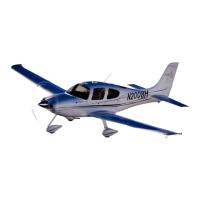P/N 13999-002 Info Manual 3A-5
Cirrus Design Section 3A
SR20 Abnormal Procedures
Ground Procedures
Brake Failure During Taxi
Ground steering is accomplished by differential braking. However,
increasing power may allow some rudder control due to increased
groundspeed and airflow over the rudder.
1. Engine Power......................................................... AS REQUIRED
• To stop airplane - REDUCE
• If necessary for steering - INCREASE
2. Directional Control ............................... MAINTAIN WITH RUDDER
3. Brake Pedal(s) ......................................................................PUMP
If directional control can not be maintained:
4. Mixture ..............................................................................CUTOFF
Aborted Takeoff
Use as much of the remaining runway as needed to safely bring the
airplane to a stop or to slow the airplane sufficiently to turn off the
runway.
1. Power Lever ............................................................................ IDLE
2. Brakes.................................................................... AS REQUIRED
• Caution •
For maximum brake effectiveness, retract flaps, hold control
yoke full back, and bring the airplane to a stop by smooth,
even application of the brakes to avoid loss of control and/or a
blown tire.
After a high-speed aborted takeoff, brake temperatures will be
elevated; subsequent aborted takeoffs or other high-energy
use of the brakes may cause brake overheat, failure and
possibly even fire. A 25-minute cooling time is recommended
following high-energy use of the brake system before
attempting to conduct operations that may require further
high-energy braking. Brake temperature indicator should be
inspected prior to flight following a high-energy brake event
(refer to Preflight Walk-Around Checklist for detail).
September 2011

